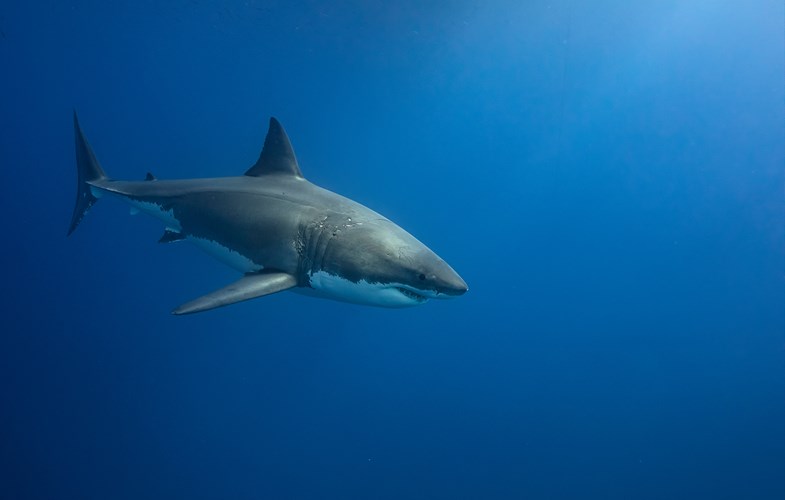

Migration, Family Ties and Protection – Unravelling the Secret Life of Great White Sharks
Great White Mystery
Great White Mystery is a scientific research project led by Dr Mauricio Hoyos, who wants to obtain more detailed knowledge about the migrations of Great White Sharks with the help of new tags. With these results, the aim is to establish no-fishing zones in cooperation with certain institutions.
The Great White Shark (Carcharodon carcharias), the functional apex of many marine food webs, is native to the cool coastal waters and the vastness of the open ocean. With an average length of 4.5 to 6.5 m, it is one of the largest predatory fish in the oceans.
The IUCN classifies the species as worldwide “Vulnerable”, in some regions even as “Critically Endangered”. Population numbers are continuously declining, a re-classification in the next assessment is highly likely. The most significant threats to Great Whites and other pelagic shark species are intentional fishing and high rates of by-catch and accidental entanglement. The increasing adverse effects of rising water temperature due to climate change impact the already dwindling population numbers even further.
Restrictions for landings and trade, methods to reduce by-catch, and targeted implementation of protection zones are essential for the worldwide protection of the species. To use these measures most effective, scientists need to understand the particular demands posed by the animals biology and life history. Although Great White Sharks are among the largest predators of the oceans, science knows surprisingly little about them. Only in recent decades have we started to fill these gaps in knowledge through advances in technology and genetic testing
A crucial region for shark research is the Island of Guadalupe — declared a biosphere
reserve in 2005 – 240 km off the coast of Baja California, Mexico. An abundance of marine life is
found here, mainly due to the favourable location in the nutrient-rich waters of the California Current. The rugged shores also house large breeding colonies of three different seal species. This abundance of prey is probably one of the main reasons for the seasonal aggregations of Great White Sharks. The annual migration routes lead from the nursery grounds along the Pacific West coast to Guadalupe. Population studies show that young males start arriving in great numbers from the beginning of July. From September onwards, the number of females increases sharply.
The waters of the protected area are considered — along with the White Shark Café — to
be one of the most crucial aggregation sites for Great Whites in the Eastern Pacific. Both adults and juveniles show strong site and migration fidelity. Genetically, the local population is distinct from aggregations off the coasts of Australia and South Africa. Guadalupe is ideal for marine biologists and an ever-growing ecotourism industry to observe the animals, mainly thanks to outstanding visibility and robust seasonal predictability.
Objectives
Sharkproject has been specifically supporting Dr Hoyos' research work since 2015. The funds provided are used to purchase MiniSur (CAT's Fincams) and VMT tags (Vemco Mobile Transceiver) which are used for population studies.
The overall objectives of the project are:
- To establish accurate migration and residency patterns of the local population through the provided MiniSur and VMTs.
- To increase the understanding of inter- (shark/prey) and intraspecific (shark/shark) interactions.
- The use of the data to expand protection zones along migration routes and collection points.
Duration
To contain the COVID-19 pandemic, travel to the region was temporarily banned, leading to delays in data collection. Sharkproject expects to resume research in 2022.
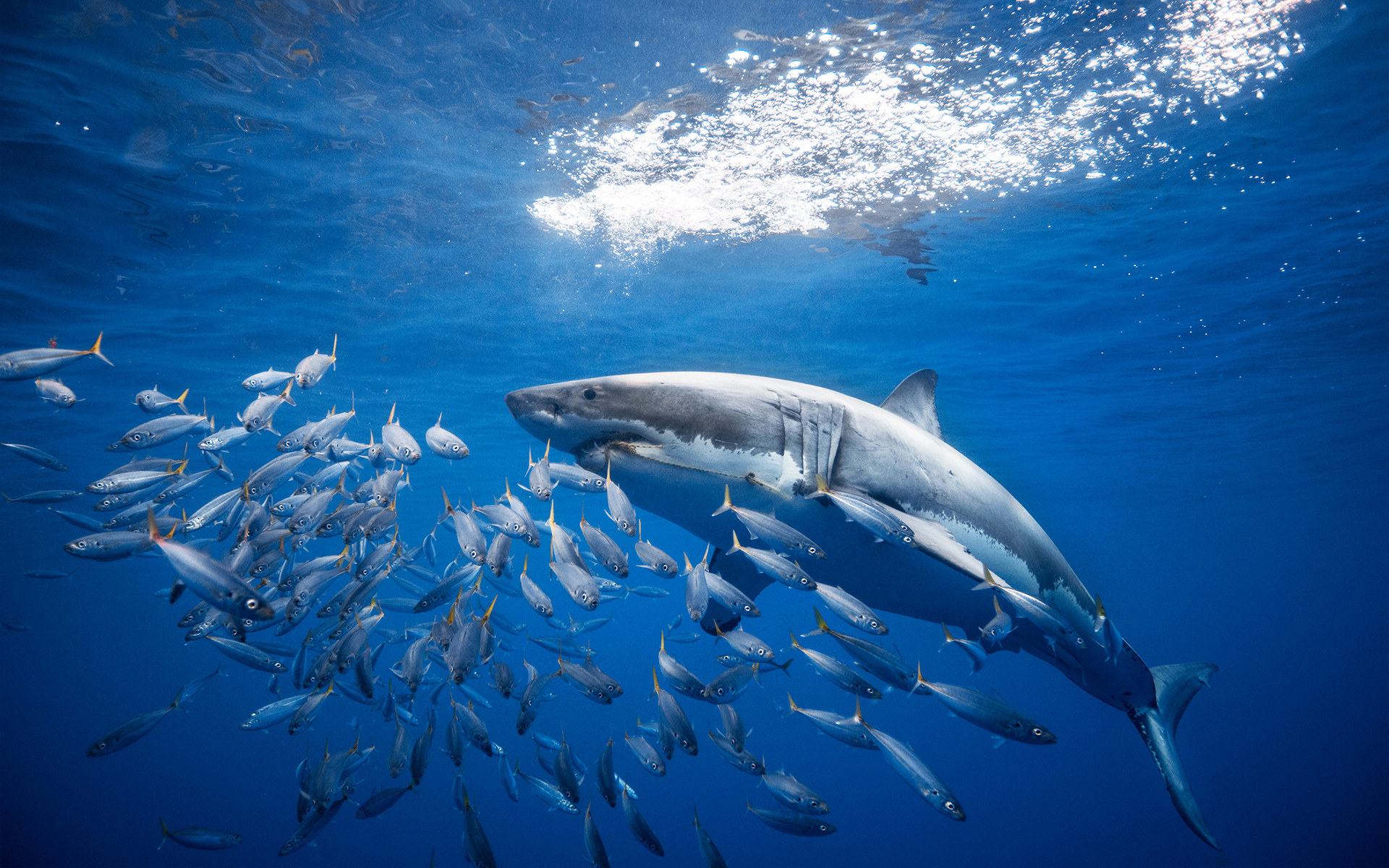
© Herbert Futterknecht
Scientists
Dr Mauricio Hoyos – Scientific Director. The research focus of the scientist (based in La Paz, Mexico) includes movement patterns and interactions of different shark species. Since 2005, he has concentrated on population analyses of White Sharks in the North Pacific, especially in the biosphere area around Guadalupe.
Dr Yannis Papastamatiou – Technical Director. As an expert in telemetry and tagging, the marine biologist (based in Florida, USA) supports various projects with a focus on behavioural and migration research. His findings contribute massively to the expansion of protection zones along migration routes of pelagic shark species.
Fred Buyle – The well-known free diver supports Dr Hoyos' team in attaching satellite tags and collecting DNA samples from great white sharks. His extensive hands-on experience and skills allow him to approach the animals in a unique way.
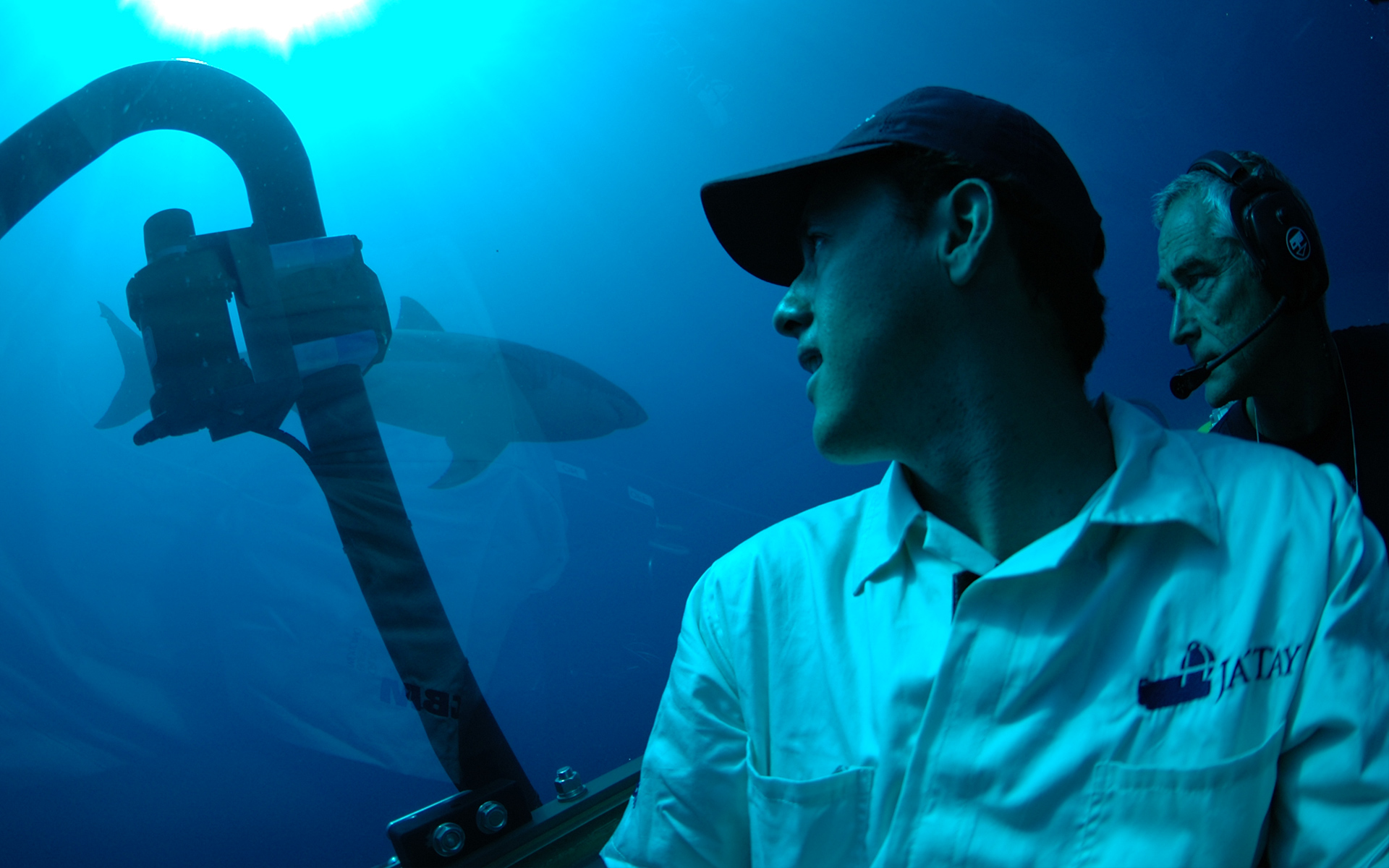
© Mauricio Hoyos
Supporters and sponsors
The Sharkproject team was generously supported with donations during the preparations and realization of the various Shark Night events. We want to thank in particular:
MARES – just add water, SEACAM, Servotel, Kubicek Fördertechnik GmbH, Reisebüro fish&trips, Unterwasserkamera.at, Printshop and Chris Benz.
Servotel and Kubicek Fördertechnik GmbH provided an additional VMT tag for Dr Hoyos.
Location
Guadalupe is a small island of volcanic origin off the west coast of Mexico. The dramatic landscape is home to numerous endemic plants and bird species; many of them endangered.
The isolated location in the otherwise turbulent and current-rich Pacific Ocean makes Guadalupe a hotspot of biodiversity. Several seal and sea lion species can be found along the protected coasts.
Not least because of this, Great White Sharks are found here in large numbers seasonally. Meanwhile, the region is considered one of their main aggregation sites in the North Pacific.
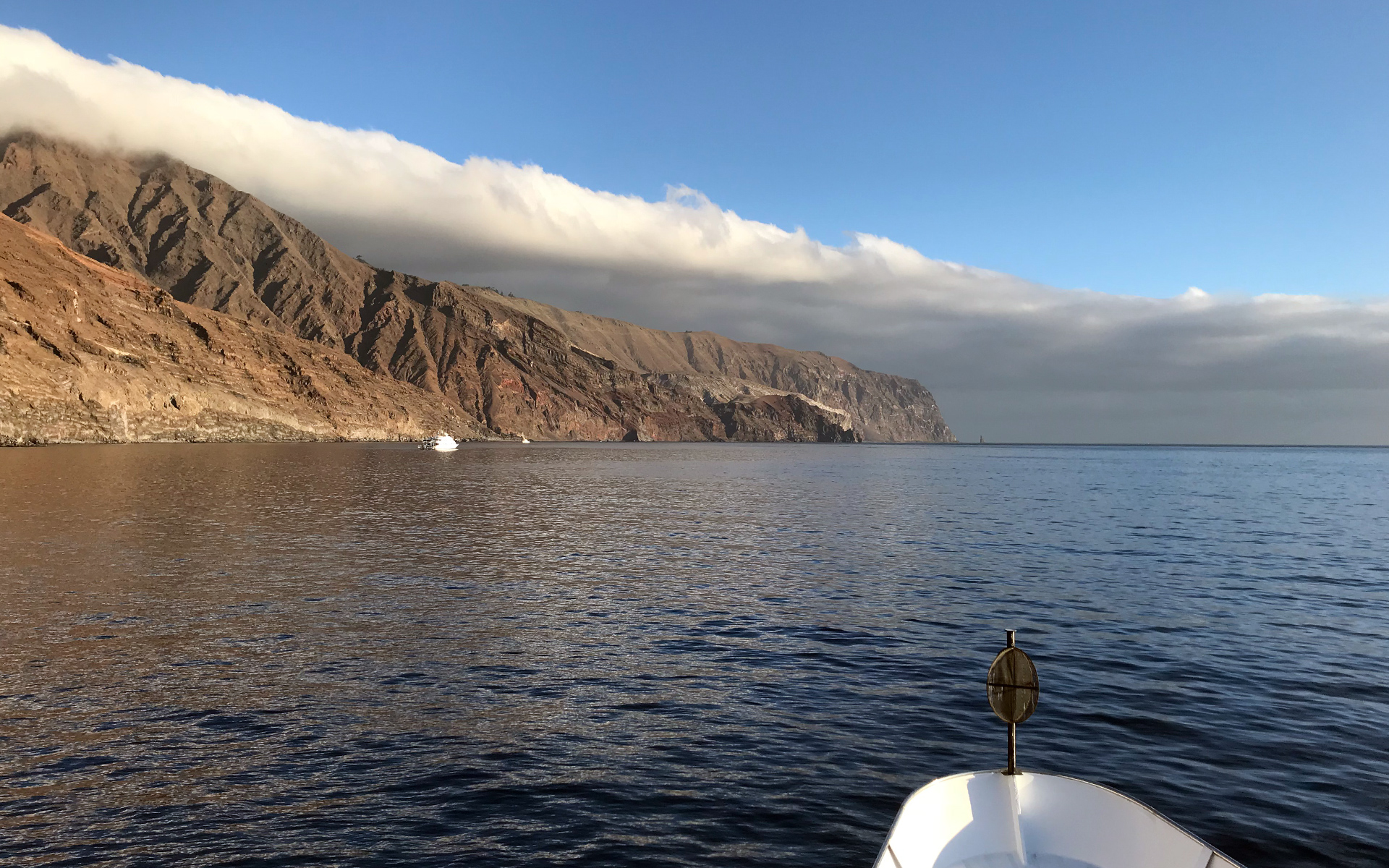
© Christine Staacks
Travels
Due to the still uncertain situation caused by the COVID-19 pandemic, no Sharkproject accompanied trips are currently planned. We will keep you informed when new dates for Guadalupe are fixed.
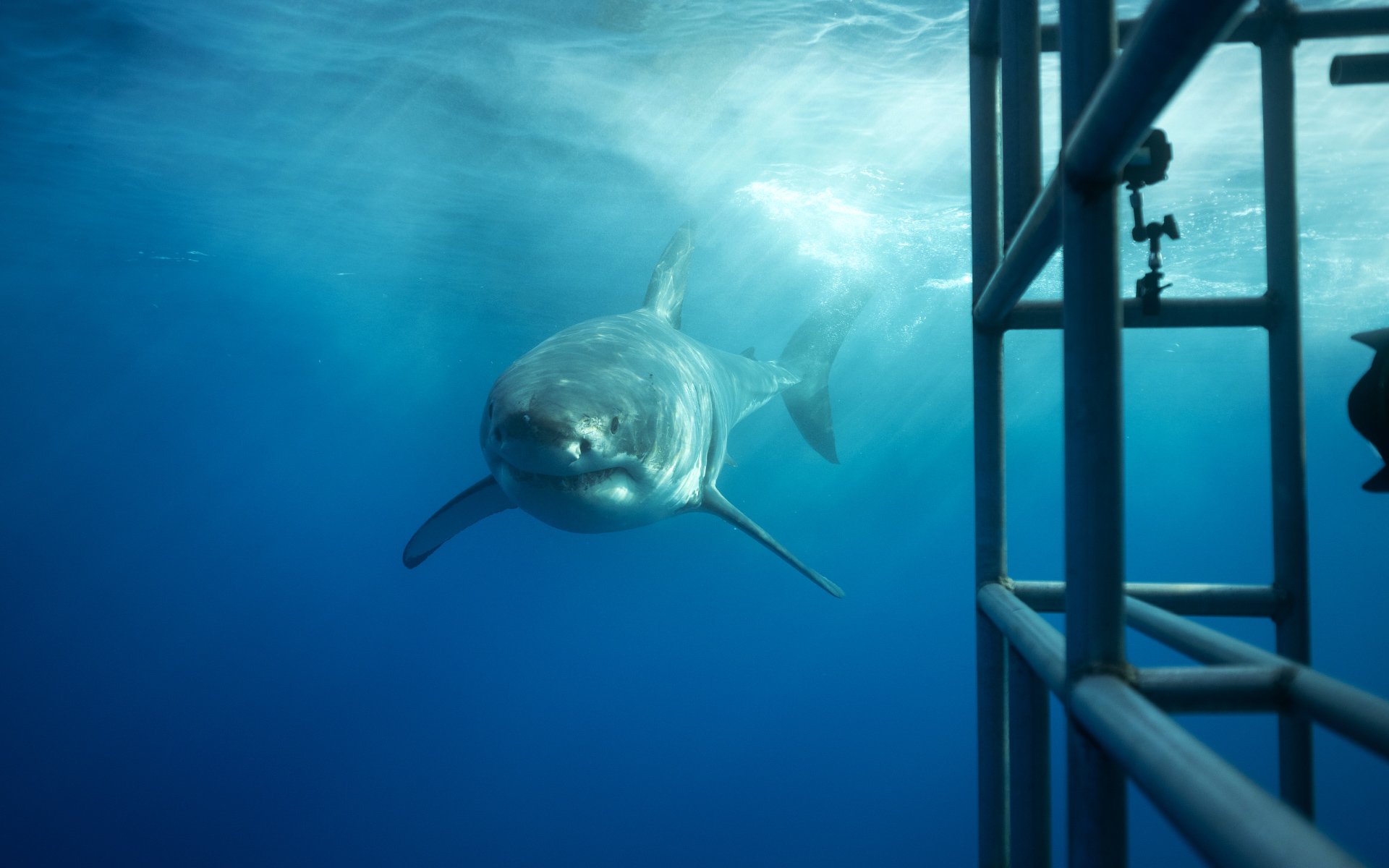
© Denise Smolinsky
Telemetry
Animal telemetry studies allow scientists to collect a variety of information using acoustic or satellite-based sensors called tags. They are mainly used to make migration patterns of pelagic species visible. The resulting movement maps allow definitive conclusions to be drawn about the animals' way of life and history.
Not only horizontal migrations are made visible by the tags, but also the notoriously difficult-to-trace vertical movements of marine species. For example, we now know that male Great White Sharks dive up to 1,200 metres off Guadalupe, while females stay much shallower. Each of these pieces of information is a small mosaic piece in the picture of “shark as mystery” – the increasingly precise tagging technologies allow us to complete this picture bit by bit.
For a long time, it was assumed that sharks have a very limited social structure; the image of the shark as a loner persists. Here, too, the tag data are the basis for a change in our understanding of the animals. Intensity and length of inter- and intraspecific interactions are recorded, revealing a complex picture of mating behaviour, social hierarchies and prey interactions.
Telemetry studies around the world have provided important insights into the movement and behavioural ecology of sharks. This knowledge now forms the basis for developing effective conservation strategies for these endangered animals. For example, the tagging studies allowed the expansion of the protection zones for white sharks in the North Pacific. Not only their breeding grounds off the coasts of North America are now protected, but also their aggregation points off Guadalupe.
Used Tags and technologies
Two types of sensors are used in the research of Guadalupe: VEMCO Mobile Transceiver (VMT) and Sonotronics MiniSUR.
The VEMCO Mobile Transceiver (VMT) is a hybrid between a transmitter and receiver, so it can not only send data to stations, but also receive data from them. Communication is possible with all common VEMCO-coded devices, and transmitters from other manufacturers can also be registered.
The detection range varies from a few 100 metres in coastal waters to 1 kilometre in the open ocean. The VMT can operate at depths up to 1000 m and is suitable for studies in deep water environments.
In the North Pacific, there are many fixed receiver stations as well as numerous stationary objects such as FADs or buoys equipped with VEMCO-coded transmitters. This allows conclusions to be drawn about migration routes and the respective residence times of the sharks. Information on the interaction with other tagged animals is also stored. This allows researchers to better understand the social structures of sharks.
Sonotronic's Miniature Submersible Ultrasonic Receiver (MiniSUR) tags were also equipped with underwater cameras (FinCams) to collect more information about the behaviour of great white sharks off Guadalupe. Image data is mainly used to identify untagged sharks and prey.
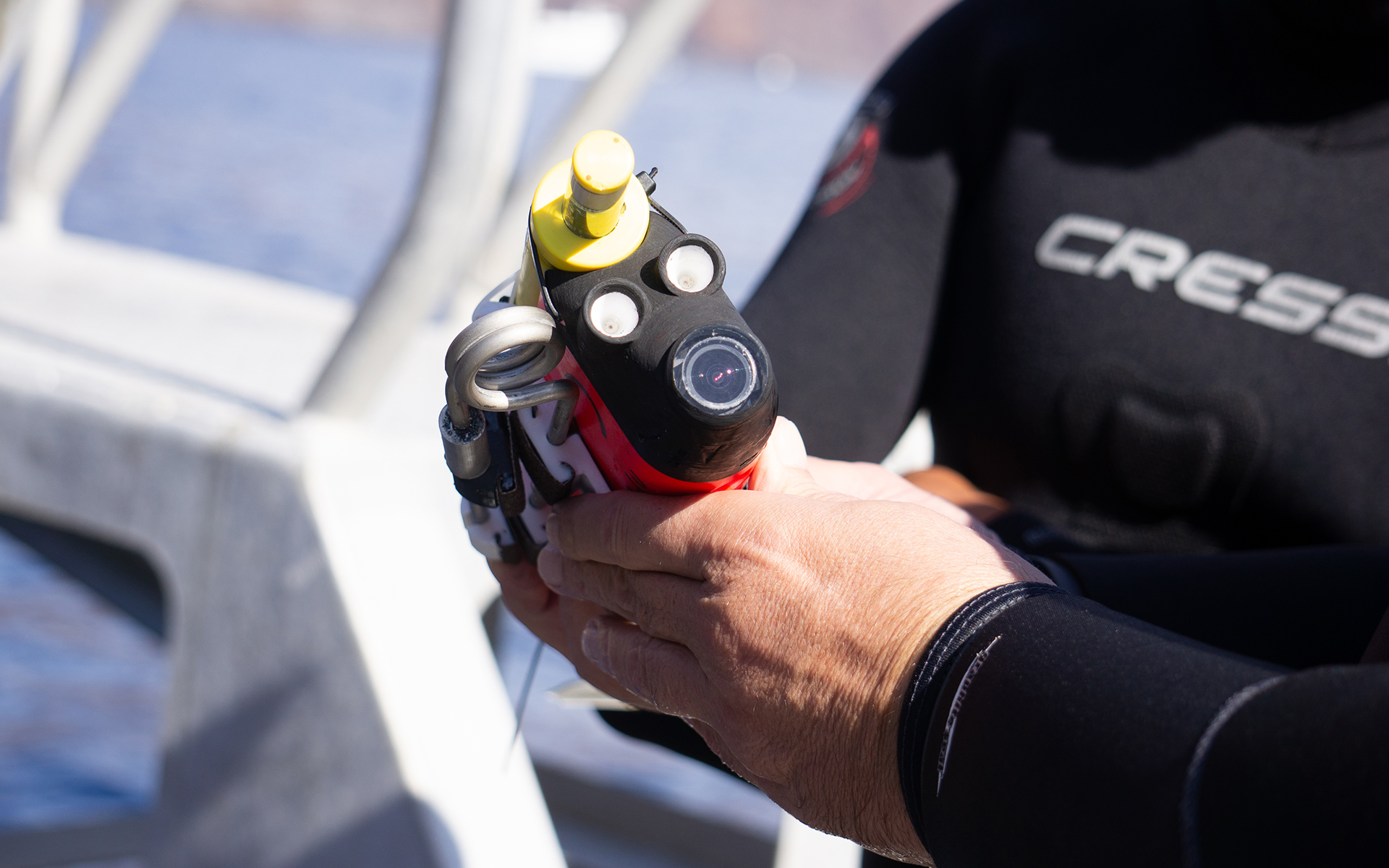
© Denise Smolinsky
Tagging procedure
Great White Sharks are lured to the research boats using bait. Depending on the type, the tags are attached directly from the boat or by free divers in the water. Both types are anchored to the dorsal fin of the animal; the VMT tags are pierced with the help of a harpoon, the MiniSUR are clamped directly to the fin with a clamping device. Neither method of attachment is known to have any negative effects on the sharks.
When removing the tags, however, the two sensor types differ. The MiniSURs detach from the animal after 12 days at the latest and float to the surface – thanks to an integrated buoyancy body. Based on satellite signals, they can be found and collected promptly. The data is read out after the tags have been successfully found.
The VMT tags remain on the shark for up to 10 months. The tags are removed in the same way as they are attached, either by free divers or by hand from a boat. Removal also poses no risk to the sharks. The data is stored and utilized by read-out devices. If it is not possible to remove the tag after 10 months – for example, because the animal has not returned to Guadalupe – the tag remains on the shark, but stops collecting data as soon as the integrated batteries are exhausted. The shark does not suffer any disadvantages by leaving the tag in place.
Unfortunately, tags are lost on a regular basis, whether through accidental detachment due to territorial fights and mating behaviour, changes in migration routes or the death of the animal.
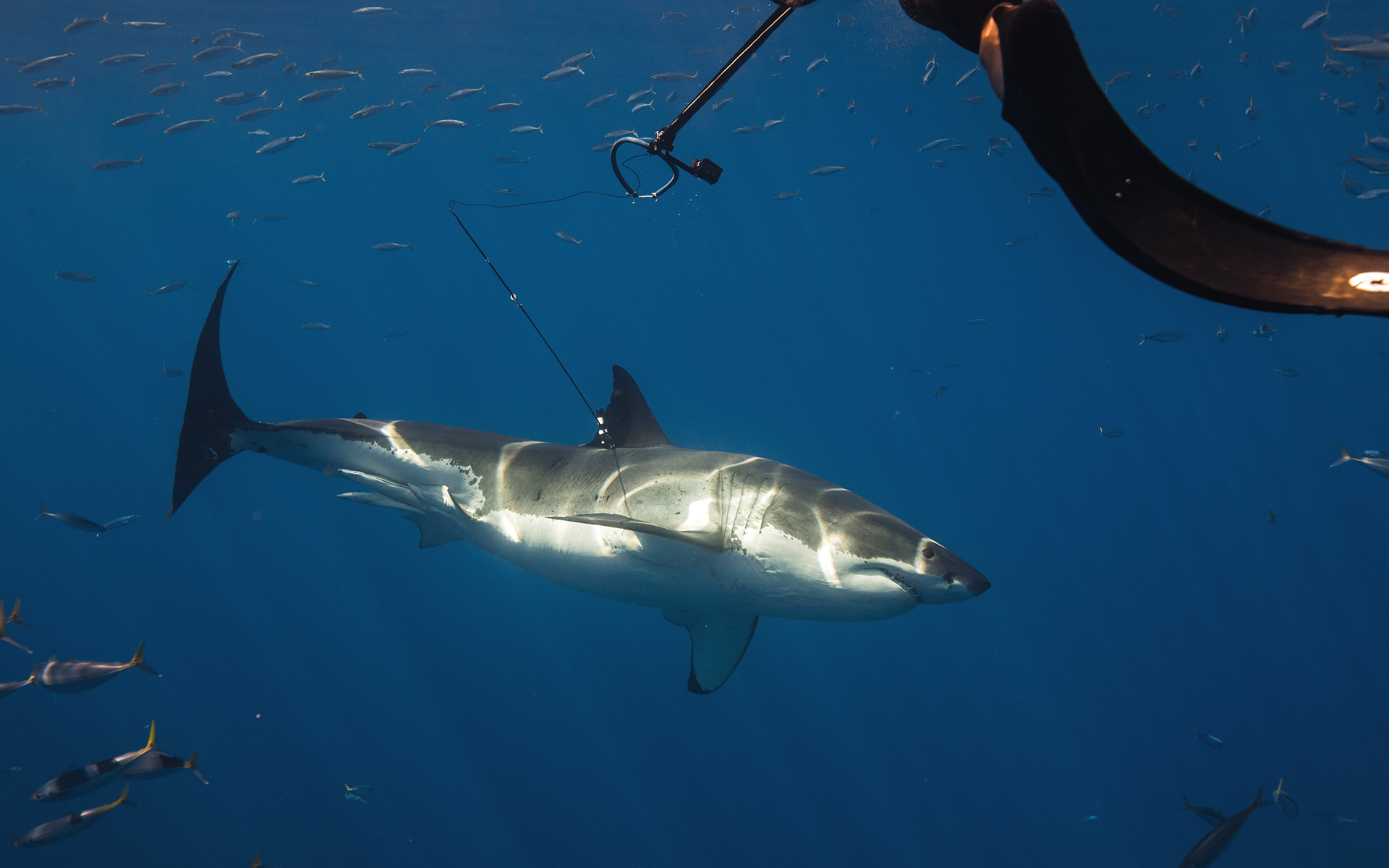
© Herbert Futterknecht
Project history
2015 start of the project
To fund the project, several Charitiy events already took place:
- 8 October 2016 in Vienna
- 3 March 2017 the Shark Noon in Cologne
- 12 May 2017 in Zurich at the Shark Night in the Masoala Rainforest of the Zurich Zoo
- 13 October 2018 in Vienna at the Arcotel Wimberger
- 2019 in Zurich
11 October to 15 October 2017
Epic Shark Expedition/Guadalupe Another 6 VMT`s were set after the Sharkproject expedition by Dr Mauricio Hoyos.
13 October 2018
The documentation on the implementation of the project from the Epic Shark Expedition in October 2017 was presented at the SharkNight Vienna at the Arcotel Wimberger Wien. Present: Dr Mauricio Hoyos, Frederic Buyle and Dr Yannis Peter Papastamatiou (technical support).
Oktober 2018
Epic Shark Expedition/Guadalupe
In 2020, Guadalupe was unfortunately not accessible for us due to Covid. Therefore, none of the VMT's could be removed from the sharks yet. But the exciting footage from the Fincam tags is currently being analysed and evaluated. We are curiously waiting to see what the Great White Sharks have filmed.
September/October 2021
Our Sharkproject-Projectleaders Herbert and Gabriela Futterknecht travelled to Guadalupe to get an overview about the current situation. We will timely announce our further plans to resume the project.
March 2022
Publication of the scientific paper on the Great White Mystery project. The findings on social dynamics and individual hunting tactics of great white sharks revealed by biologging. Link to the publication of the paper: https://royalsocietypublishing.org/doi/10.1098/rsbl.2021.0599
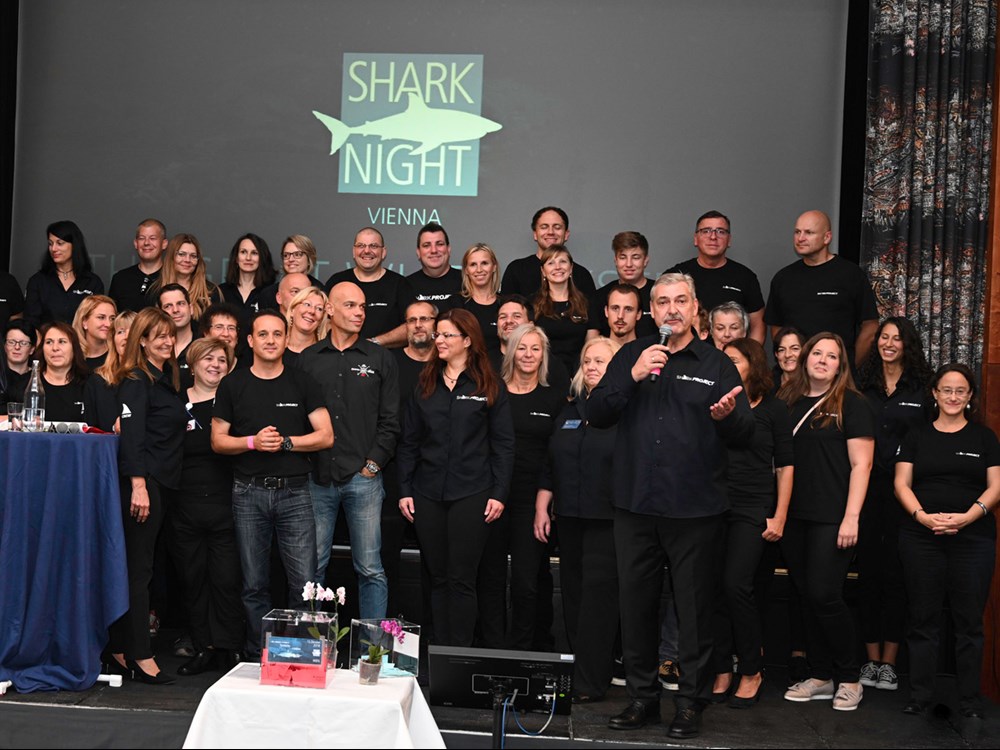
© Franz Hajek

© Harald Minarik
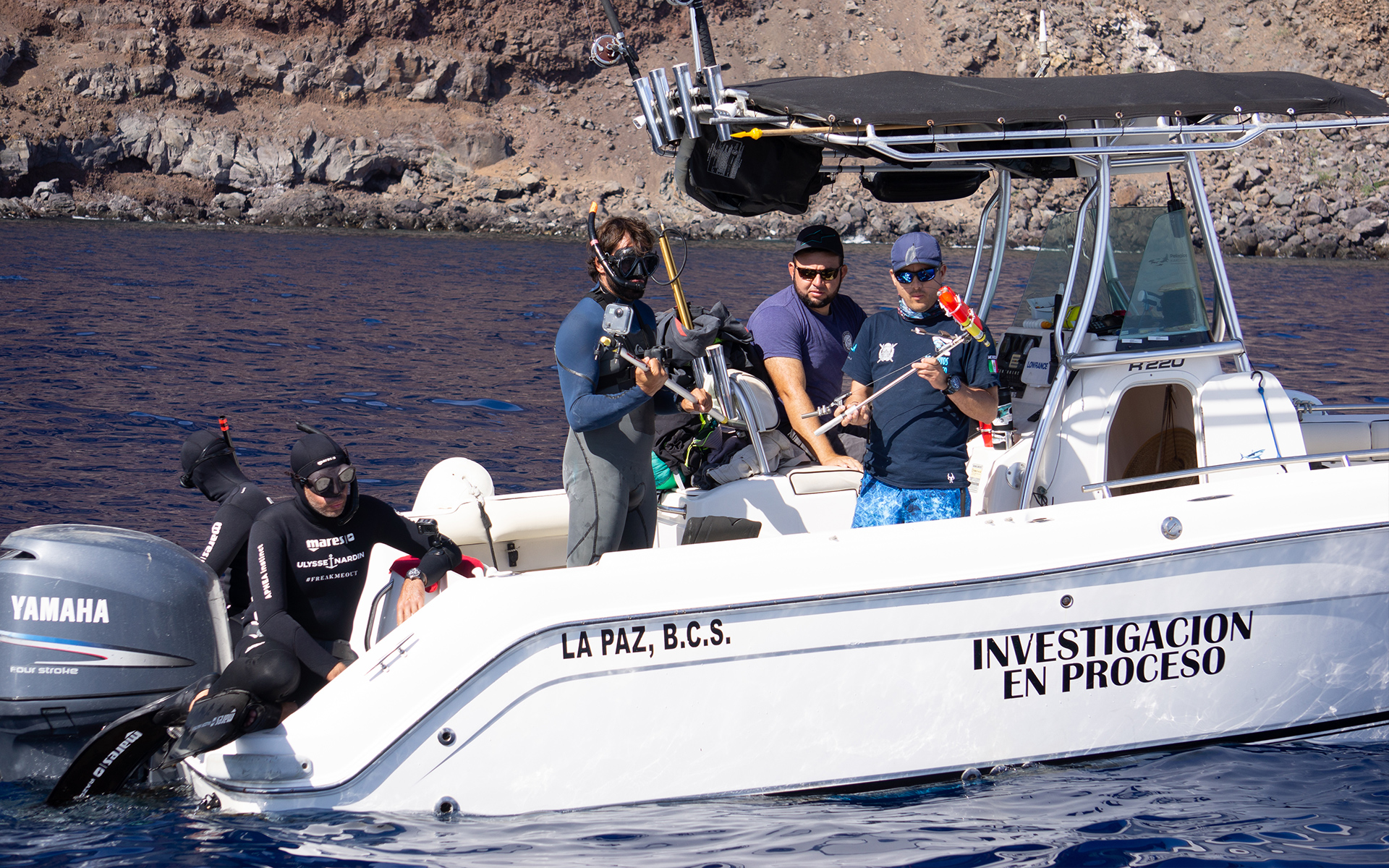
© Denise Smolinsky
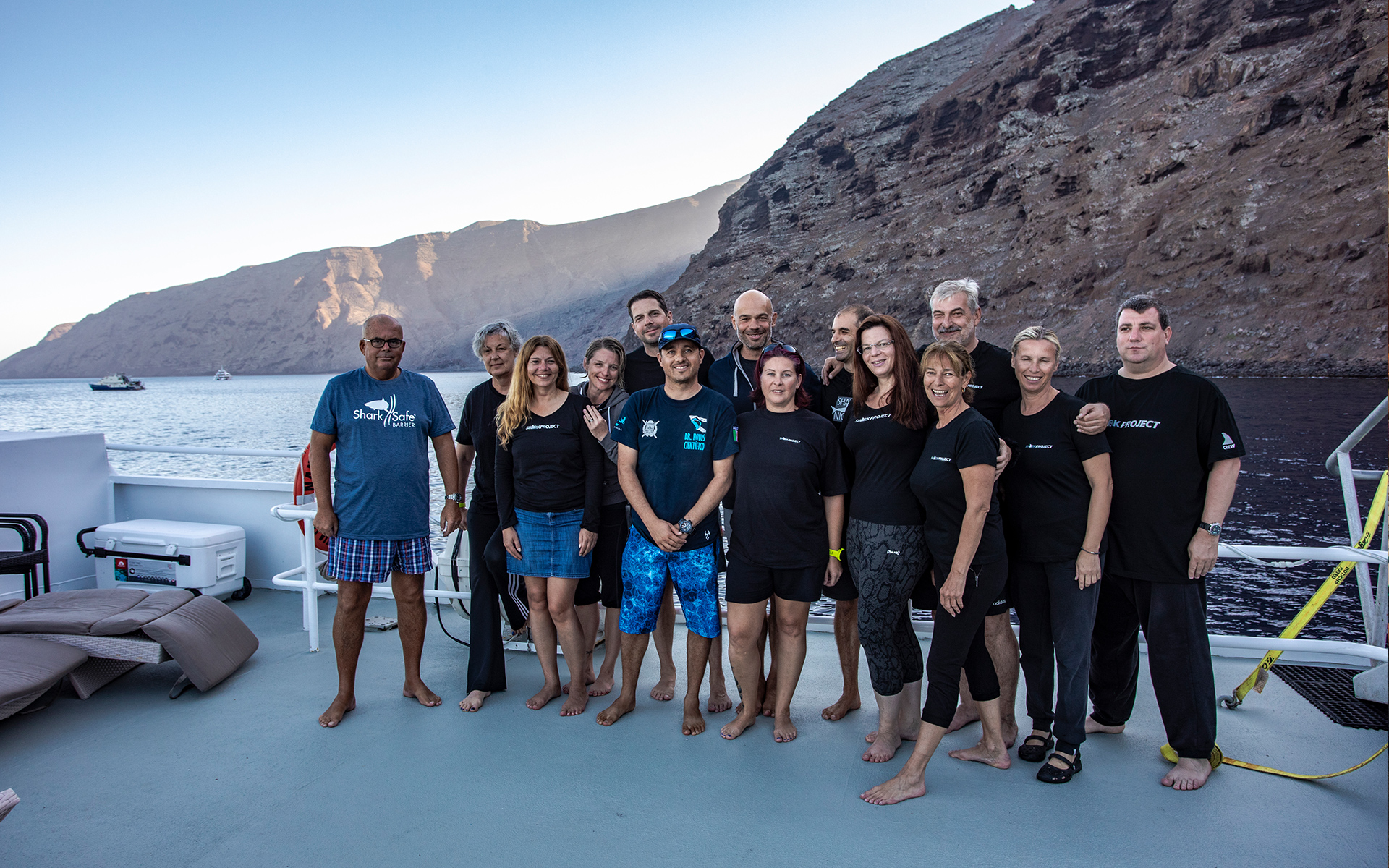
© Herbert Futterknecht
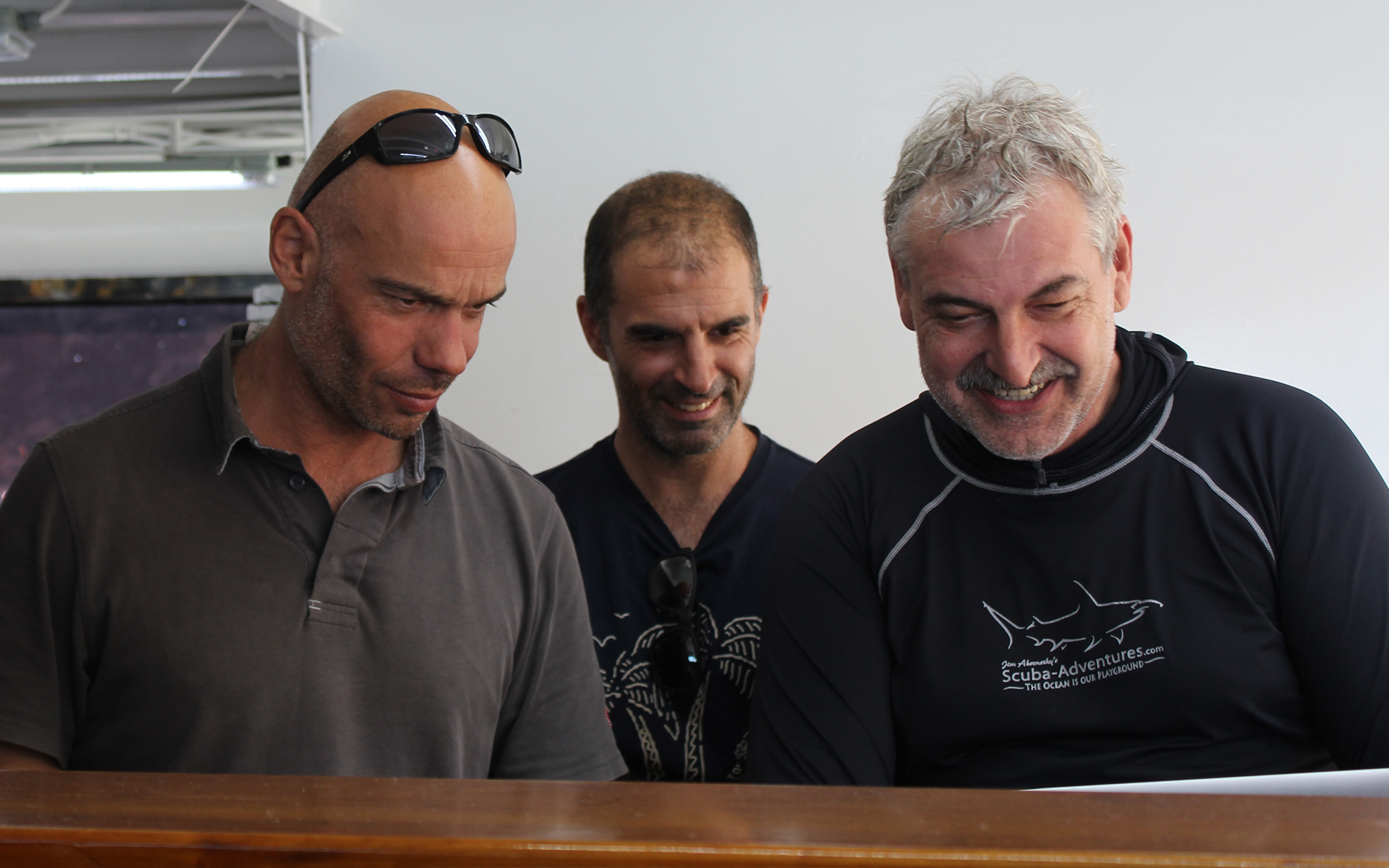
© Christine Staacks

